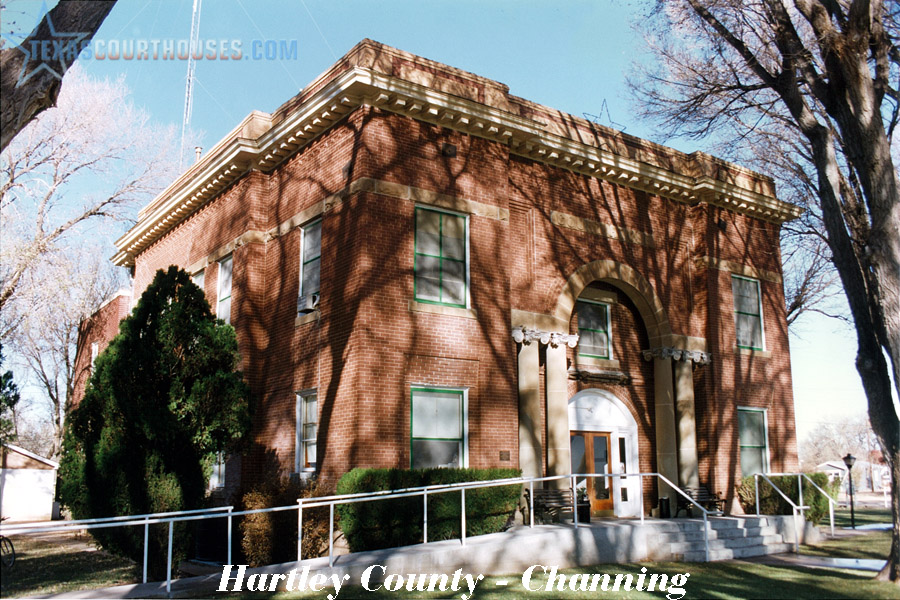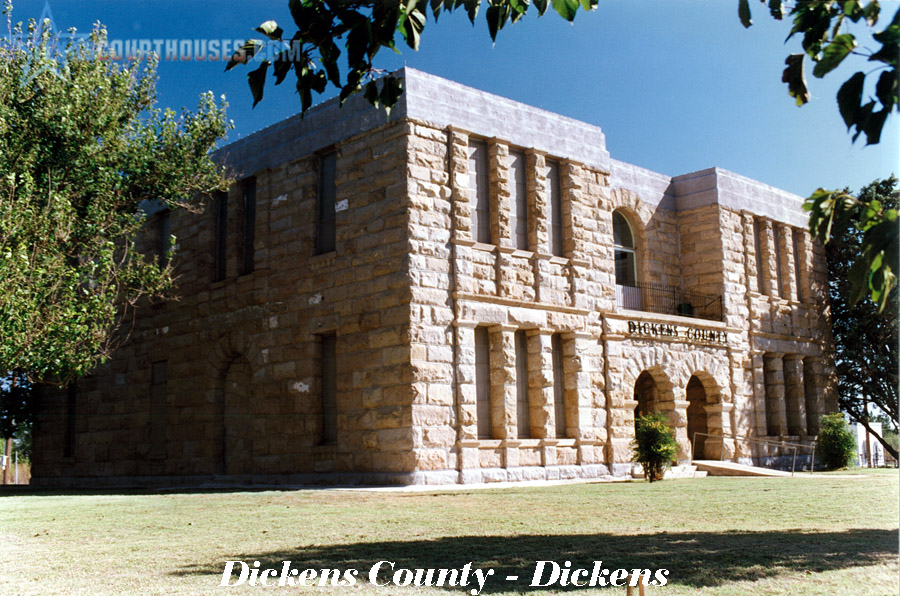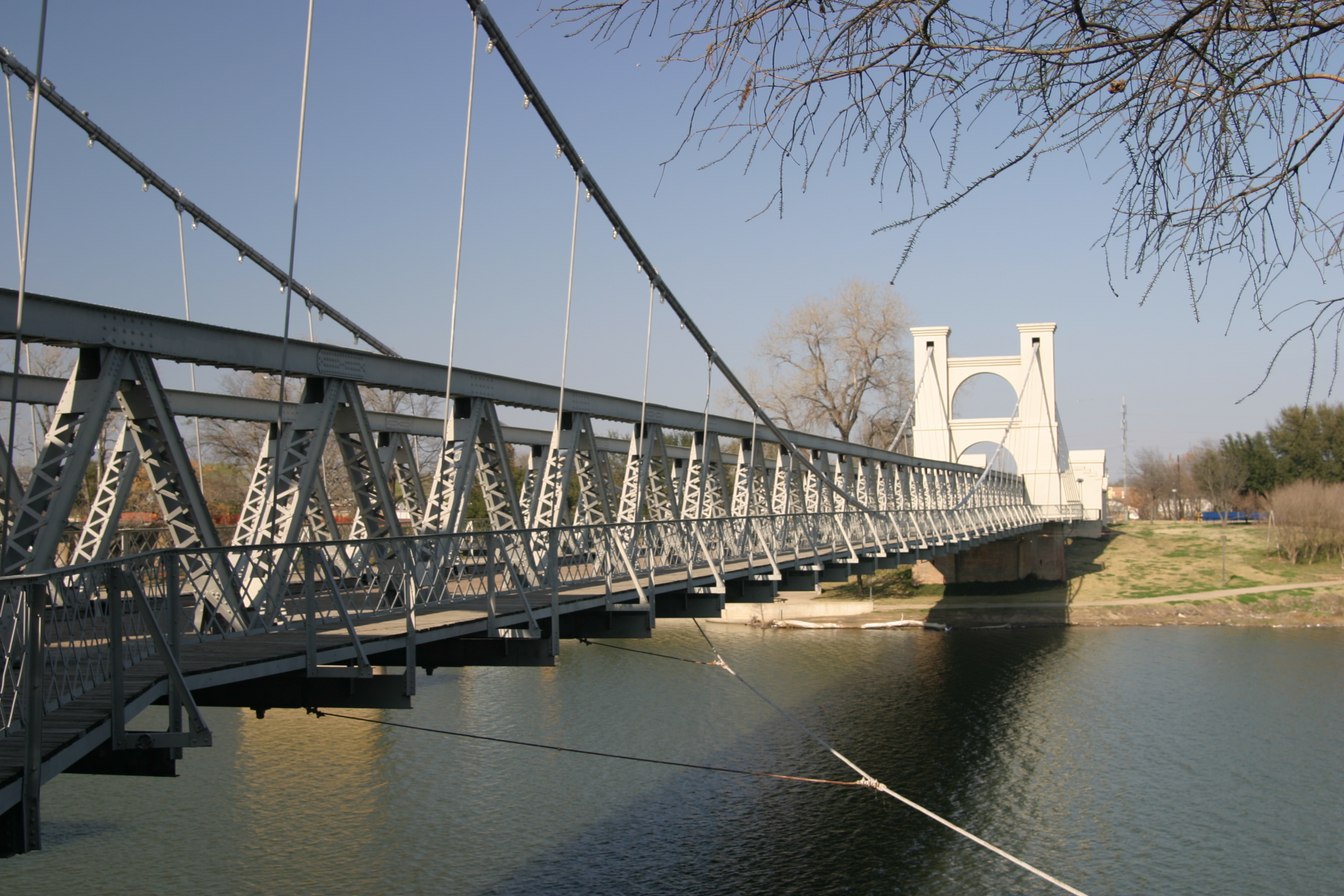1st Courthouse
Building Completion Date: 1891
County Seat: Hartley. Moved to Channing 1896
Present Status: Gone
General Contractor: W. M. Andrews
Building Materials/Description: 24′ x 70′ wood. $8,000 to build and $90 to move it to Channing
2nd Courthouse
Building Completion Date: 1906
County Seat: Hartley
Present Status: Existing. Active.
Architect: O. G. Rouquemore
Architectural Style: Classical Revival
General Contractor: Solon & Wickens (of Amarillo)
Building Materials/Description: Brick. $14,000. The Courthouse is a symmetrical, rectangular, freestanding structure. -1935- $7,000 addition made.
National Register Narrative: The Hartley County Courthouse and Jail comprise one of the oldest and most intact complexes of this type in the Panhandle/South Plains region of Texas. Additions to the two structures have had minimal effects on their integrity, and they retain their historic ambiance to an unusual degree. The Classical Revival/Romanesque Courthouse and Jail occupy the equivalent of a full block in the town of Channing (1980 population 320). The site, however, is not a typical courthouse square with adjacent commercial buildings; rather, it faces the Fort Worth and Denver Railroad tracks in an older, mixed-use area.
The Courthouse is a symmetrical, rectangular, freestanding structure. The main block was originally roughly square in shape with a center hall plan, but later additions to the rear (considered contributing) brought the structure to its current configuration. The two-story structure has a three-bay entrance (south) facade with a Palladian entryway supported by paired Ionic columns. Brickwork is in a common bond pattern, and a stone beltcourse encircles the main block. A cornice element with modillion blocks and brick panels above surmounts the original building. The sides of the main block are five bays wide. The original one-over-one windows were replaced with four-pane aluminum windows, but the divided, wooden screens maintain the historic appearance. The later rear addition continues in a somewhat simplified manner the architectural vocabulary of the original structure. It lacks the cornice and has six-over-six symmetrically-placed windows.
The interior of the Courthouse remains largely unchanged. The central hall on the main floor has county offices on each side. The ceilings are generally covered with pressed tin, and early ceiling fans survive. The second floor is reached by a two run staircase with landing located over the front door. The major room on the second floor is the courtroom, which retains its high, pressed tin ceilings and fans. A hand rail encircles the courtroom, and the front of the room is separate from public seating by a low classical balustrade. The two-story brick jail is located immediately to the northwest of the Courthouse. The historic facades have symmetrically-placed round headed four-over- four windows, with bars over the second floor windows. A stone beltcourse acts as lintel to the upper windows; it is surmounted by a simple brick parapet. The interior of the jail is essentially utilitarian with little significant detailing. A small, low, one-story, modern ranch house style addition to the rear of the jail serves as jailer’s residence. It occupies a very inconspicuous site and does not affect the historic integrity of the complex.
The site is flat but quite distinctive by virtue of the fully mature Chinese elm trees planted in a checkerboard pattern. In a part of the state not known for its trees, the Hartley County Courthouse elms are a distinctive and memorable feature. A fence encircles the property.
The Hartley County Courthouse and Jail are one of the oldest, most intact and architecturally significant courthouse complexes in the Texas Panhandle/South Plains region. The Courthouse has served as the seat of justice in Hartley County since 1906 and thus has a pivotal role in the county; because of this it meets Criteria A. Architecturally, the Courthouse is an exceptional Beaux Arts structure built in a frontier environment, and it is unquestionably the most notable building in its style in the county and one of the most notable in the region; accordingly it meets National Register Criterion C also. The Courthouse and Jail relate to Texas County Courthouse Complexes, 1880-1930.
From the end of Reconstruction until the advent of the Great Depression, Texas courthouses were not only the functional seat of county government but were also symbolic of the wealth, ambition and sophistication of the county. As elsewhere in the United States, they tended to be the focal point of political functions in the county. Furthermore, there was an intense boosterism among the citizens of rival frontier (and settled) counties, each of whom nurtured hopes that their jurisdiction would emerge as the next Dallas, Galveston or El Paso County. In many of Texas’ 254 counties, the Courthouse complex was, and in many cases still is, the most architecturally pretentious grouping of buildings locally. Most were architect-designed. Later 19th century courthouses were usually vertical, masonry, aspiring high style structures reflecting Second Empire, Romanesque or Renaissance Revival styles. Early 20th-century courthouses demonstrated Beaux Arts, Prairie Style or, in later years, Art Deco influence. Detached jails, a second Property Type, reflected on a smaller scale the architecture of the Courthouse; in the 20th century these became simpler in design. A third Property Type would be the statuary or monuments frequently found on the courthouse grounds.
In 1885, the famed, three million acre, XIT ranch was created by a syndicate of Chicago investors, who had received the vast tract in then counties in exchange for constructing the 1880’s Texas State Capitol (N.H.L. 1986). In 1890, the ranch headquarters was moved near the present site of Channing, and in effect a company town was created. Hartley County, created in 1876, was formally organized in 1891 and the County Seat established at Hartley Station. In 1896, however, the XIT Ranch forced an election to move the seat to Channing; the vote was 91 in favor of the move and 25 against, and accordingly the frame courthouse was moved on wheels to its new location by a group of XIT cowboys.
The frame courthouse and company town status of Channing and Hartley County might have lasted indefinitely, but after the turn-of-the-century it became apparent that the XIT was unwieldy and that lands would be sold. According to historian David Murrah, the development of the Texas Panhandle was to be the last major area of colonization arguably in the continental United States and the last large scale railroad construction. Hartley County would therefore be vying with other counties for new settlers, and the need for a handsome and commodious courthouse became much greater.
In 1905, the Hartley County Commissioners Court authorized the County Judge to advertise for plans and specifications for a new courthouse to be built of brick, stone and mortar on Block 107 in the town of Channing. On December 4, 1905, a contract was signed with Solan & Wilkins, contractors, and Otho Gibson Roquemore, architect, for the construction of the new courthouse.
Roquemore (1856-1925) was a native of Tobotow, Georgia, but was reared by his grandfather in Panola County, Texas. While he attended Baylor University, it is not apparent that he had formal training in architecture. He began his practice in 1886 in Gainesville, a cattle-boom town north of Fort Worth and in 1900 he moved to a greater cattle-boom city, Amarillo, in the remote Texas Panhandle. He met with a degree of success there. He supervised the construction of the 1904 Potter County Courthouse, and was known to have been architect of the Johnson Street School (1905) and the Amarillo City Hall/Fire Station (1906). He is also credited with the design of the Central Presbyterian Church, the Episcopal Church and many of the larger business and public buildings in Potter County and surrounding country. He later moved to Dallas, where he died. Unfortunately most of Roquemore’s buildings have been demolished or not identified, making comparisons of his designs difficult.
Architecturally, the Hartley County Courthouse is exceptional. The population of the county at the time of its construction was low, less than 1000, and in 1980 there were just under 4000 people. Accordingly, the Courthouse is much more diminutive than the castle-like courthouses found in other areas. Rather, the Hartley County Courthouse has almost a domestic scale. With the Beaux Arts inspired triumphal arch entrance front, the Courthouse almost has the appearance of a rather solid Palladian villa or smaller Carnegie library. The rows of mature elms, the fine turn-of- the-century interiors and the complimentary two-story jail all contribute to the character of the property. The 1935 addition respected the massing and materials of the original composition, and the modern jailers residence connected to the jail is sited discreetly toward the rear of the property. Thus the complex retains its integrity to an unusual degree.
The subsequent history of the courthouse had been one of few sensational trials or great events. According to Hartley County Historical Commission Chairman Patricia Kirkeminde, the courthouse trials were generally for stolen cattle, bootlegging and gaming. But after serving eighty years as the seat of Hartley County government, the Courthouse and occasionally the jail have played an important role in the lives of County citizens. Fortunately successive County Commissioners Courts have respected the integrity of the complex, and the Courthouse has been a source of pride to citizens and visitors alike.
The periods of significance for nomination of the structure under Architecture, 1906 and 1935, reflect the two building campaigns for the Courthouse; the jail was constructed at the earlier date. The period for the Politics/Government Area of Significance extends from 1906, when the present courthouse was placed in service, until 1937, the National Register fifty year cut-off date.
The Hartley County Courthouse and Jail were evaluated by comparisons of contemporaneous and geographically similar courthouses by personal observation and research in reference works on Texas courthouses, such as Willard B. Robinson’s The People’s Architecture and June Rayfield Welch’s Texas Courthouse Revisited. Jails have been less well documented, but ‘Historical Texas County Jails’ by Craig M. Cowden provides information on jail building and design in Texas.



